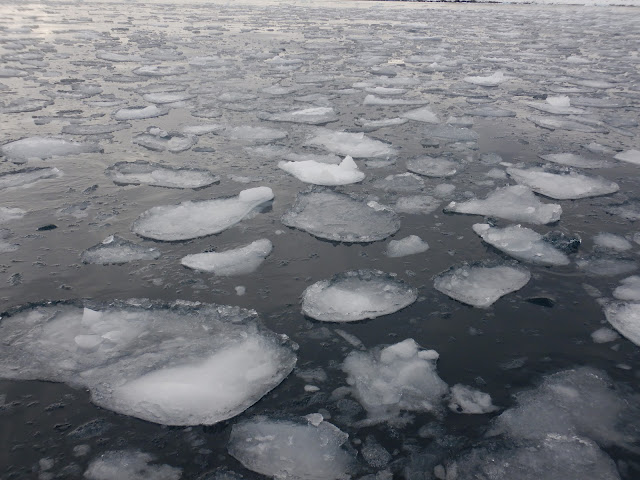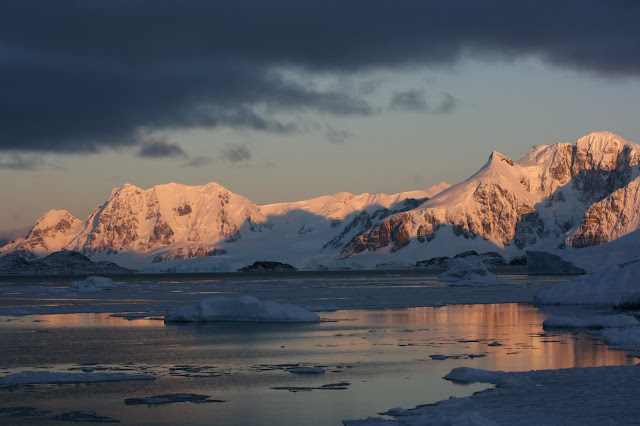Pancake Ice and Winter
Our training on the James Clark Ross (click to view a previous blogpost) introduced us to stoves and Tilley lamps which, at the time, seemed hard to imagine the use for while sailing through the tropics. However, when moving around Antarctica, the utility of devices to keep warm is certainly more relevant and much welcomed. On weekends and bank holidays, it is common for people to skin up to the caboose - a small red refuge hut (a reconverted shipping container) - ski or snowboard in some fresh snow and warm up with a cuppa. Interestingly, melting a whole pot of snow yields only a minute amount of water, when expressed as a volume, the snow to ice ratio is 10 parts snow to 1 part water. Bearing in mind this is fresh snow and ice is denser and cutting ice blocks yields a greater volume than the equivalent volume of snow.
The caboose - at the bottom of 'Vals', a gentle ski slope
An excellent place for a cuppa!
Primus stoves and Tilley lamps inside the Caboose
As the chilly winter kicks in, it's a great relief to go inside the refuge hut, and make us of the intended purpose of the caboose: re-warming with some melted snow and chocolate powder. On extra cold days, lighting the Tilley lamp generates enough heat to get the circulation going in your fingers again!
Klara (station doctor) in the caboose.
Even inside the refuge it's cold, down jacket needed!
With increased snowfall, previously rocky areas have now become skiable routes. Nordic skiing is a new sport I've taken up and what a delight it is to have light skis on your feet compared to clunky traditional down-hill skiing boots. These thin skis, as exhibited by Jas in the photos below, are fitted with a small scaly artificial skin to help with grip but also allowing you to move with speed. Unlike downhill skiing, you don't need to remove the 'skins' when transitioning terrain. Nordic skiing is generally made for flat terrain and your feet are clipped in at all times. When you get really good at it, it's possible to move fluidly by sliding with your feet in a triangular formation.
Jas Nordic skiing around the point
Nordic skiing with Rothera station in the background
We observed our first pancake ice on the 19th March. Pancake ice is a term used to describe circular formations of sea ice with rimmed edges as a result of colliding with other ice. It is commonly formed amongst frazil ice and grease ice (a thin layer of greasy looking ice). When the floating ice rinds of grease break up, pancake ice pieces form as a result.
Until now, we had observed only berg fragments and porridge ice (essentially a slushy layer of mostly unconsolidated ice) but this marks an exciting transition into the stages of sea ice formation. We have subsequently witnessed the process of 'rafting' where pancake ice pieces have joined together or pushed on top of each other forming solid young ice sheets,
The process of sea ice formation
Pancake ice formation around Anchorage Island, Ryder Bay
Back in the diving world, the sea has reached freezing point, with our most recent lowest water temperature record (3rd May) at -1.7°C. After about 20 minutes in the water, you can really start to feel that winter chill and you certainly don't want to remain stationary for too long! At the same time, there is something quite magical about getting kitted up in the snow before a dive...
Kitting up in the snow with Ryan- Photo credit: Pete Hill
It's easy to keep track of the divers when the surface has frozen, Photo credit: Pete Hill
Ryan and I preparing to dive below the freezing water surface, Photo credit: Pete Hill
Post-dive thinking 'where's the tea?', Photo credit: Ryan Mathews
We don't always dive from the boats and as the sea ice starts to form, this will certainly be out of the question as the small RIBS are not equipped to break through ice. Whilst the water is free-flowing and free from fast ice, shore diving allows us to access local sites with minimal fuss. The set up is analogous to how we will operate on sea ice. All dive gear, including life lines and communication box is loaded into a trailer and pulled along by a skidoo to the shoreline.
We are loosing daylight fast but as a result, we are getting some excellent sunrises over the Antarctic mountains located on the peninsula. As I write, the sun is rising at 11:00 am. Walking to work in the dark is a strange transition, though with clear skies littered with stars, it's worth it. Similarly, by the time the working day is over, the sun has already set (15:45 today!).
In a few weeks time, will will say goodbye to the sun with a ceremony at the highest vantage point (the cross) to say goodbye to our star.
Morning sunrise over North Cove
Late morning light - view from my office
In the meantime, on still days with low wind, sea ice is gradually forming around Ryder Bay.
Sea ice sheets in Ryder Bay encapsulating icebergs


























holy moly absolutely love reading these Nadia! The pictures are stunning and you're adventures sound epic!!! Much love xxxx
ReplyDeleteThank you so much anonymous!! Who are you!!!
ReplyDelete